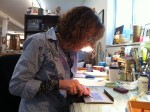Artist Robin Atlas in studio. (photo from Robin Atlas)
Midrash has been an integral part of Jewish culture for centuries, mainly in literary form. It also branches into the visual arts, however, and there exists a vibrant, international alliance of artists investigating the sacred texts through their paintings and sculpture, fibre art and theatre. Robin Atlas, a Seattle-based mixed-media artist, is part of the movement, and she considers it a personal challenge to raise the awareness of visual midrash in the Jewish community and beyond.
Atlas has been exploring visual midrash for the past four years. Her new show at the Zack Gallery, Lashon Hara, A Narrative on the Consequences of Evil Speech, highlights some of the results of her exploration.
“I turned to this theme after I suffered from an evil tongue myself,” she shared in an interview with the Independent. “Someone gossiped about me. She said very unpleasant things behind my back and then to my face. I was very upset. I talked to my rabbi’s wife, and she sensed my disquiet. She asked me what happened. When I told her, she said, ‘What lashon hara!’ I asked her what that meant, and she told me. It means ‘evil speech’ or ‘evil tongue.’ I started thinking about it. I felt it was a powerful subject to explore through art. Lashon hara creates pain and darkness. How do we turn this darkness into light? What could I, as an artist, say about it? Our community needed such a conversation.”
The exhibition is Atlas’ contemplation on the topic, its different approaches and consequences. Through the use of textile art, she examines how lashon hara impacts the spiritual realm and the physical world. The show consists of 20 small, framed canvas squares decorated with various materials: beads, appliqués, strings, paint and so on. Each piece is imbued with its own symbolism, and the artist’s explanations of her vision are handwritten on the attached labels.
“I started this project by researching the subject for several months,” she said. “I began with seven titles and then created the pieces to match them. But I felt that seven wasn’t enough, so I thought of 13 more titles and the related art pieces.”
One piece in particular, “Feather Pillow,” encompasses the idea behind the show. It might be seen as an illustration to a story. “It’s a Jewish folk story. I heard it first when I was a young girl,” Atlas recalled. “I did something bad, gossiped about someone, and my grandmother told me that story. When I started investigating lashon hara, I remembered the story again, and it became the foundation for one of the pieces.”
A small panel with the full text of that story hangs next to the artwork. The story compares gossip to a feather. Once on the air, flying away, it can’t be caught and retracted, and those who spread the gossip commit three murders: they kill the souls of the speaker, the listener and the one about whom they gossip. “Three Murders,” another piece in the show, illustrates the point.
Several pieces reflect the artist’s personal way of dealing with gossip, converting its darkness into light. One is called “Bomb,” but Atlas’ depiction is not a weapon: the beautiful, sparkling-with-golden-beads image depicts an unusual bomb, a bomb of kindness. “It’s a retaliation of love,” Atlas said. “We have to stop the circle of evil speech. It’s about that woman who spoke evil of me.”
Although she used the vehicle of the Torah to convey her introspections, lashon hara is not confined to the Torah or the Jewish community, of course. There are examples of “evil tongue” everywhere, in our personal and work lives, in the public sphere. In this respect, the show is both timely and timeless, resonating with everyone of every nation or culture, and age.
The show also has an interactive aspect. “We invite the public to write down small notes: how lashon hara affected them, whether it was something they said or something said about them. The notes are anonymous,” Atlas explained. “Anyone can pin his or her note about their experience of lashon hara to a special board. We provide the papers, the pencils and the pins. At the end of the show, we’ll collect all the notes, shred them and turn them into mulch, to be used for a plant at the JCC. We will, this way, symbolically turn the darkness of lashon hara into light.”
During the opening reception on May 29, Rabbi Carey Brown of Temple Sholom joined Atlas for the Artist’s Beit Midrash, a discussion of lashon hara. The exhibit runs until June 22.
Olga Livshin is a Vancouver freelance writer. She can be reached at [email protected].

